Glass
Glass is a non-crystalline amorphous solid that is often transparent and has widespread practical, technological, and decorative usage in, for example, window panes, tableware, and optoelectronics. Scientifically, the term "glass" is often defined in a broader sense, encompassing every solid that possesses a non-crystalline (that is, amorphous) structure at the atomic scale and that exhibits a glass transition when heated towards the liquid state.
The most familiar, and historically the oldest, types of glass are "silicate glasses" based on the chemical compound silica (silicon dioxide, or quartz), the primary constituent of sand. The term glass, in popular usage, is often used to refer only to this type of material, which is familiar from use as window glass and in glass bottles. Of the many silica-based glasses that exist, ordinary glazing and container glass is formed from a specific type called soda-lime glass, composed of approximately 75% silicon dioxide (SiO2), sodium oxide (Na2O) from sodium carbonate (Na2CO3), calcium oxide, also called lime (CaO), and several minor additives. A very clear and durable quartz glass can be made from pure silica, but the high melting point and very narrow glass transition of quartz make glassblowing and hot working difficult. In glasses like soda lime, the compounds added to quartz are used to lower the melting temperature and improve workability, at a cost in the toughness, thermal stability, and optical transmittance.
Many applications of silicate glasses derive from their optical transparency, which gives rise to one of silicate glasses' primary uses as window panes. Glass will transmit, reflect and refract light; these qualities can be enhanced by cutting and polishing to make optical lenses, prisms, fine glassware, and optical fibers for high speed data transmission by light. Glass can be colored by adding metallic salts, and can also be painted and printed with vitreous enamels. These qualities have led to the extensive use of glass in the manufacture of art objects and in particular, stained glass windows. Although brittle, silicate glass is extremely durable, and many examples of glass fragments exist from early glass-making cultures. Because glass can be formed or molded into any shape, and also because it is a sterile product, it has been traditionally used for vessels: bowls, vases, bottles, jars and drinking glasses. In its most solid forms it has also been used for paperweights, marbles, and beads. When extruded as glass fiber and matted as glass wool in a way to trap air, it becomes a thermal insulating material, and when these glass fibers are embedded into an organic polymer plastic, they are a key structural reinforcement part of the composite material fiberglass. Some objects historically were so commonly made of silicate glass that they are simply called by the name of the material, such as drinking glasses and reading glasses.
In science, porcelains and many polymer thermoplastics familiar from everyday use are glasses too. These sorts of glasses can be made of quite different kinds of materials than silica: metallic alloys, ionic melts, aqueous solutions, molecular liquids, and polymers. For many applications, like glass bottles or eyewear, polymer glasses (acrylic glass, polycarbonate or polyethylene terephthalate) are a lighter alternative than traditional glass.
Silicate glass
Ingredients
Silica (the chemical compound SiO2) is a common fundamental constituent of glass. In nature, vitrification of quartz occurs when lightning strikes sand, forming hollow, branching rootlike structures called fulgurite.
Fused quartz is a glass made from chemically-pure SiO2 (silica). It has excellent thermal shock characteristics, being able to survive immersion in water while red hot. However, its high melting-temperature (1723 °C) and viscosity make it difficult to work with.[1] Normally, other substances are added to simplify processing. One is sodium carbonate (Na2CO3, "soda"), which lowers the glass transition temperature. The soda makes the glass water-soluble, which is usually undesirable, so lime (calcium oxide [CaO], generally obtained from limestone), some magnesium oxide (MgO) and aluminium oxide (Al2O3) are added to provide for a better chemical durability. The resulting glass contains about 70 to 74% silica by weight and is called a soda-lime glass.[2] Soda-lime glasses account for about 90% of manufactured glass.
Most common glass contains other ingredients to change its properties. Lead glass or flint glass is more 'brilliant' because the increased refractive index causes noticeably more specular reflection and increased optical dispersion. Adding barium also increases the refractive index. Thorium oxide gives glass a high refractive index and low dispersion and was formerly used in producing high-quality lenses, but due to its radioactivity has been replaced by lanthanum oxide in modern eyeglasses. Iron can be incorporated into glass to absorb infrared energy, for example in heat absorbing filters for movie projectors, while cerium(IV) oxide can be used for glass that absorbs UV wavelengths.[3]
The following is a list of the more common types of silicate glasses, and their ingredients, properties, and applications:
- Fused quartz, also called fused silica glass, vitreous silica glass, is silica (SiO2) in vitreous or glass form (i.e., its molecules are disordered and random, without crystalline structure). It has very low thermal expansion, is very hard, and resists high temperatures (1000–1500 °C). It is also the most resistant against weathering (caused in other glasses by alkali ions leaching out of the glass, while staining it). Fused quartz is used for high temperature applications such as furnace tubes, lighting tubes, melting crucibles, etc.
- Soda-lime-silica glass, window glass: silica 72% + sodium oxide (Na2O) 14.2% + lime (CaO) 10.0% + magnesia (MgO) 2.5% + alumina (Al2O3) 0.6%. Is transparent, easily formed and most suitable for window glass (see flat glass). It has a high thermal expansion and poor resistance to heat (500–600 °C). It is used for windows, some low temperature incandescent light bulbs, and tableware. Container glass is a soda-lime glass that is a slight variation on flat glass, which uses more alumina and calcium, and less sodium and magnesium which are more water-soluble. This makes it less susceptible to water erosion.
- Sodium borosilicate glass, Pyrex: silica 81% + boric oxide (B2O3) 12% + soda (Na2O) 4.5% + alumina (Al2O3) 2.0%. Stands heat expansion much better than window glass. Used for chemical glassware, cooking glass, car head lamps, etc. Borosilicate glasses (e.g. Pyrex) have as main constituents silica and boron oxide. They have fairly low coefficients of thermal expansion (7740 Pyrex CTE is 3.25×10–6/°C[4] as compared to about 9×10−6/°C for a typical soda-lime glass[5] ), making them more dimensionally stable. The lower coefficient of thermal expansion (CTE) also makes them less subject to stress caused by thermal expansion, thus less vulnerable to cracking from thermal shock. They are commonly used for reagent bottles, optical components and household cookware.
- Lead-oxide glass, crystal glass: silica 59% + lead oxide (PbO) 25% + potassium oxide (K2O) 12% + soda (Na2O) 2.0% + zinc oxide (ZnO) 1.5% + alumina 0.4%. Because of its high density (resulting in a high electron density) it has a high refractive index, making the look of glassware more brilliant (called "crystal", though of course it is a glass and not a crystal). It also has a high elasticity, making glassware "ring". It is also more workable in the factory, but cannot stand heating very well.
- Aluminosilicate glass: silica 57% + alumina 16% + lime 10% + magnesia 7.0% + barium oxide (BaO) 6.0% + boric oxide (B2O3) 4.0%. Extensively used for fiberglass, used for making glass-reinforced plastics (boats, fishing rods, etc.) and for halogen bulb glass.
- Oxide glass: alumina 90% + germanium oxide (GeO2) 10%. Extremely clear glass, used for fiber-optic waveguides in communication networks. Light loses only 5% of its intensity through 1 km of glass fiber.[6] Most optical fiber is based on silica, as are all the glasses above.
Another common glass ingredient is crushed alkali glass or "cullet" ready for recycled glass. The recycled glass saves on raw materials and energy. Impurities in the cullet can lead to product and equipment failure. Fining agents such as sodium sulfate, sodium chloride, or antimony oxide may be added to reduce the number of air bubbles in the glass mixture.[2] Glass batch calculation is the method by which the correct raw material mixture is determined to achieve the desired glass composition.
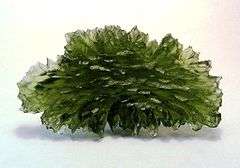
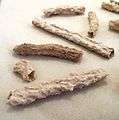 Tube fulgurites
Tube fulgurites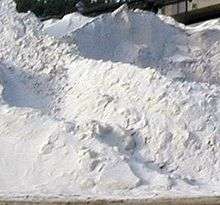 Quartz sand (silica) is the main raw material in commercial glass production
Quartz sand (silica) is the main raw material in commercial glass production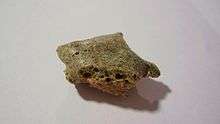 Trinitite, a glass made by the Trinity nuclear weapon test
Trinitite, a glass made by the Trinity nuclear weapon test
Physical properties
Optical properties
Glass is in widespread use largely due to the production of glass compositions that are transparent to visible light. In contrast, polycrystalline materials do not generally transmit visible light.[7] The individual crystallites may be transparent, but their facets (grain boundaries) reflect or scatter light resulting in diffuse reflection. Glass does not contain the internal subdivisions associated with grain boundaries in polycrystals and hence does not scatter light in the same manner as a polycrystalline material. The surface of a glass is often smooth since during glass formation the molecules of the supercooled liquid are not forced to dispose in rigid crystal geometries and can follow surface tension, which imposes a microscopically smooth surface. These properties, which give glass its clearness, can be retained even if glass is partially light-absorbing—i.e., colored.[8]
Glass has the ability to refract, reflect, and transmit light following geometrical optics, without scattering it. It is used in the manufacture of lenses and windows. Common glass has a refraction index around 1.5. This may be modified by adding low-density materials such as boron, which lowers the index of refraction (see crown glass), or increased (to as much as 1.8) with high-density materials such as (classically) lead oxide (see flint glass and lead glass), or in modern uses, less toxic oxides of zirconium, titanium, or barium. These high-index glasses (inaccurately known as "crystal" when used in glass vessels) cause more chromatic dispersion of light, and are prized for their diamond-like optical properties.
According to Fresnel equations, the reflectivity of a sheet of glass is about 4% per surface (at normal incidence in air), and the transmissivity of one element (two surfaces) is about 90%. Glass with high germanium oxide content also finds application in optoelectronics—e.g., for light-transmitting optical fibers.
 A wine glass
A wine glass Simple optical device: the magnifying glass
Simple optical device: the magnifying glass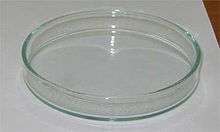 Glass petri dish
Glass petri dish
Other properties
In the process of manufacture, silicate glass can be poured, formed, extruded and molded into forms ranging from flat sheets to highly intricate shapes. The finished product is brittle and will fracture, unless laminated or specially treated, but is extremely durable under most conditions. It erodes very slowly and can withstand the action of water. It is resilient to chemical attack and is an ideal material for the manufacture of containers for foodstuffs and most chemicals.
Contemporary production
Following the glass batch preparation and mixing, the raw materials are transported to the furnace. Soda-lime glass for mass production is melted in gas fired units. Smaller scale furnaces for specialty glasses include electric melters, pot furnaces, and day tanks.[2] After melting, homogenization and refining (removal of bubbles), the glass is formed. Flat glass for windows and similar applications is formed by the float glass process, developed between 1953 and 1957 by Sir Alastair Pilkington and Kenneth Bickerstaff of the UK's Pilkington Brothers, who created a continuous ribbon of glass using a molten tin bath on which the molten glass flows unhindered under the influence of gravity. The top surface of the glass is subjected to nitrogen under pressure to obtain a polished finish.[9] Container glass for common bottles and jars is formed by blowing and pressing methods. This glass is often slightly modified chemically (with more alumina and calcium oxide) for greater water resistance. Further glass forming techniques are summarized in the table Glass forming techniques.
Once the desired form is obtained, glass is usually annealed for the removal of stresses. Surface treatments, coatings or lamination may follow to improve the chemical durability (glass container coatings, glass container internal treatment), strength (toughened glass, bulletproof glass, windshields), or optical properties (insulated glazing, anti-reflective coating).
 Impurities give the glass its color
Impurities give the glass its color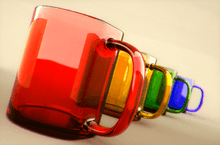 Some of the many color possibilities of glass
Some of the many color possibilities of glass Transparent and opaque examples
Transparent and opaque examples Glass can be blown into an infinite number of shapes
Glass can be blown into an infinite number of shapes
Color
Color in glass may be obtained by addition of electrically charged ions (or color centers) that are homogeneously distributed, and by precipitation of finely dispersed particles (such as in photochromic glasses).[10] Ordinary soda-lime glass appears colorless to the naked eye when it is thin, although iron(II) oxide (FeO) impurities of up to 0.1 wt%[11] produce a green tint, which can be viewed in thick pieces or with the aid of scientific instruments. Further FeO and Cr2O3 additions may be used for the production of green bottles. Sulfur, together with carbon and iron salts, is used to form iron polysulfides and produce amber glass ranging from yellowish to almost black.[12] A glass melt can also acquire an amber color from a reducing combustion atmosphere. Manganese dioxide can be added in small amounts to remove the green tint given by iron(II) oxide. When used in art glass or studio glass is colored using closely guarded recipes that involve specific combinations of metal oxides, melting temperatures and "cook" times. Most colored glass used in the art market is manufactured in volume by vendors who serve this market, although there are some glassmakers with the ability to make their own color from raw materials.
History of silicate glass

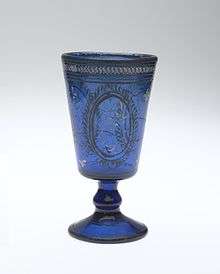


Naturally occurring glass, especially the volcanic glass obsidian, has been used by many Stone Age societies across the globe for the production of sharp cutting tools and, due to its limited source areas, was extensively traded. But in general, archaeological evidence suggests that the first true glass was made in coastal north Syria, Mesopotamia or ancient Egypt.[13] The earliest known glass objects, of the mid third millennium BCE, were beads, perhaps initially created as accidental by-products of metal-working (slags) or during the production of faience, a pre-glass vitreous material made by a process similar to glazing.[14]
Glass remained a luxury material, and the disasters that overtook Late Bronze Age civilizations seem to have brought glass-making to a halt. Indigenous development of glass technology in South Asia may have begun in 1730 BCE.[15] In ancient China, though, glassmaking seems to have a late start, compared to ceramics and metal work. The term glass developed in the late Roman Empire. It was in the Roman glassmaking center at Trier, now in modern Germany, that the late-Latin term glesum originated, probably from a Germanic word for a transparent, lustrous substance.[16] Glass objects have been recovered across the Roman empire in domestic, industrial and funerary contexts.
Glass was used extensively during the Middle Ages. Anglo-Saxon glass has been found across England during archaeological excavations of both settlement and cemetery sites. Glass in the Anglo-Saxon period was used in the manufacture of a range of objects including vessels, beads, windows and was also used in jewelry. From the 10th-century onwards, glass was employed in stained glass windows of churches and cathedrals, with famous examples at Chartres Cathedral and the Basilica of Saint Denis. By the 14th-century, architects were designing buildings with walls of stained glass such as Sainte-Chapelle, Paris, (1203–1248)[17] and the East end of Gloucester Cathedral.[18] Stained glass had a major revival with Gothic Revival architecture in the 19th-century. With the Renaissance, and a change in architectural style, the use of large stained glass windows became less prevalent. The use of domestic stained glass increased until most substantial houses had glass windows. These were initially small panes leaded together, but with the changes in technology, glass could be manufactured relatively cheaply in increasingly larger sheets. This led to larger window panes, and, in the 20th-century, to much larger windows in ordinary domestic and commercial buildings.
In the 20th century, new types of glass such as laminated glass, reinforced glass and glass bricks have increased the use of glass as a building material and resulted in new applications of glass. Multi-storey buildings are frequently constructed with curtain walls made almost entirely of glass. Similarly, laminated glass has been widely applied to vehicles for windscreens. While glass containers have always been used for storage and are valued for their hygienic properties, glass has been utilized increasingly in industry. Optical glass for spectacles has been used since the late Middle Ages. The production of lenses has become increasingly proficient, aiding astronomers as well as having other application in medicine and science. Glass is also employed as the aperture cover in many solar energy systems.
From the 19th century, there was a revival in many ancient glass-making techniques including cameo glass, achieved for the first time since the Roman Empire and initially mostly used for pieces in a neo-classical style. The Art Nouveau movement made great use of glass, with René Lalique, Émile Gallé, and Daum of Nancy producing colored vases and similar pieces, often in cameo glass, and also using luster techniques. Louis Comfort Tiffany in America specialized in stained glass, both secular and religious, and his famous lamps. The early 20th-century saw the large-scale factory production of glass art by firms such as Waterford and Lalique. From about 1960 onwards there have been an increasing number of small studios hand-producing glass artworks, and glass artists began to class themselves as in effect sculptors working in glass, and their works as part fine arts.
In the 21st century, scientists observing the properties of ancient stained glass windows, in which suspended nanoparticles prevent UV light from causing chemical reactions that change image colors, are developing photographic techniques that use similar stained glass to capture true color images of Mars for the 2019 ESA Mars Rover mission.[19]
Chronology of advances in architectural glass
- 1226: "Broad Sheet" first produced in Sussex.
- 1330: "Crown glass" for art work and vessels first produced in Rouen, France. "Broad Sheet" also produced. Both were also supplied for export.
- 1500s: A method of making mirrors out of plate glass was developed by Venetian glassmakers on the island of Murano, who covered the back of the glass with a mercury-tin amalgam, obtaining near-perfect and undistorted reflection.
- 1620: "Blown Plate" first produced in London. Used for mirrors and coach plates.
- 1678: "Crown Glass" first produced in London. This process dominated until the 19th century.
- 1843: An early form of "Float Glass" invented by Henry Bessemer, pouring glass onto liquid tin. Expensive and not a commercial success.
- 1874: Tempered glass is developed by Francois Barthelemy Alfred Royer de la Bastie (1830-1901) of Paris, France by quenching almost molten glass in a heated bath of oil or grease.
- 1888: "Machine Rolled" glass introduced allowing patterns to be introduced.
- 1898: "Wired Cast" glass invented by Pilkington for use where safety or security was an issue.
- 1959: "Float Glass" launched in UK. Invented by Sir Alastair Pilkington.[20]
 Mouth-blown window-glass in Sweden Kosta Glasbruk, (1742) with a pontil mark from the glassblower's pipe
Mouth-blown window-glass in Sweden Kosta Glasbruk, (1742) with a pontil mark from the glassblower's pipe A building in Canterbury, England, which displays its long history in different building styles and glazing of every century from the 16th to the 20th included.
A building in Canterbury, England, which displays its long history in different building styles and glazing of every century from the 16th to the 20th included. Windows in the choir of the Basilica of Saint Denis, one of the earliest uses of extensive areas of glass. (early 13th-century architecture with restored glass of the 19th-century)
Windows in the choir of the Basilica of Saint Denis, one of the earliest uses of extensive areas of glass. (early 13th-century architecture with restored glass of the 19th-century).jpg) "Hardwick Hall, more glass than wall". (late 16th-century)
"Hardwick Hall, more glass than wall". (late 16th-century) Windows at Österreichische Postsparkasse, Vienna, (early 20th-century)
Windows at Österreichische Postsparkasse, Vienna, (early 20th-century) Westin Bonaventure Hotel, USA, show the extensive use of glass as a building material in the 20th-21st centuries
Westin Bonaventure Hotel, USA, show the extensive use of glass as a building material in the 20th-21st centuries
Other types of glass
New chemical glass compositions or new treatment techniques can be initially investigated in small-scale laboratory experiments. The raw materials for laboratory-scale glass melts are often different from those used in mass production because the cost factor has a low priority. In the laboratory mostly pure chemicals are used. Care must be taken that the raw materials have not reacted with moisture or other chemicals in the environment (such as alkali or alkaline earth metal oxides and hydroxides, or boron oxide), or that the impurities are quantified (loss on ignition).[21] Evaporation losses during glass melting should be considered during the selection of the raw materials, e.g., sodium selenite may be preferred over easily evaporating SeO2. Also, more readily reacting raw materials may be preferred over relatively inert ones, such as Al(OH)3 over Al2O3. Usually, the melts are carried out in platinum crucibles to reduce contamination from the crucible material. Glass homogeneity is achieved by homogenizing the raw materials mixture (glass batch), by stirring the melt, and by crushing and re-melting the first melt. The obtained glass is usually annealed to prevent breakage during processing.[21][22]
To make glass from materials with poor glass forming tendencies, novel techniques are used to increase cooling rate, or reduce crystal nucleation triggers. Examples of these techniques include aerodynamic levitation (cooling the melt whilst it floats on a gas stream), splat quenching (pressing the melt between two metal anvils) and roller quenching (pouring the melt through rollers).
Network glasses

Some glasses that do not include silica as a major constituent may have physico-chemical properties useful for their application in fiber optics and other specialized technical applications. These include fluoride glasses, aluminosilicates, phosphate glasses, borate glasses, and chalcogenide glasses.
There are three classes of components for oxide glasses: network formers, intermediates, and modifiers. The network formers (silicon, boron, germanium) form a highly cross-linked network of chemical bonds. The intermediates (titanium, aluminium, zirconium, beryllium, magnesium, zinc) can act as both network formers and modifiers, according to the glass composition. The modifiers (calcium, lead, lithium, sodium, potassium) alter the network structure; they are usually present as ions, compensated by nearby non-bridging oxygen atoms, bound by one covalent bond to the glass network and holding one negative charge to compensate for the positive ion nearby. Some elements can play multiple roles; e.g. lead can act both as a network former (Pb4+ replacing Si4+), or as a modifier.
The presence of non-bridging oxygens lowers the relative number of strong bonds in the material and disrupts the network, decreasing the viscosity of the melt and lowering the melting temperature.
The alkali metal ions are small and mobile; their presence in glass allows a degree of electrical conductivity, especially in molten state or at high temperature. Their mobility decreases the chemical resistance of the glass, allowing leaching by water and facilitating corrosion. Alkaline earth ions, with their two positive charges and requirement for two non-bridging oxygen ions to compensate for their charge, are much less mobile themselves and also hinder diffusion of other ions, especially the alkalis. The most common commercial glasses contain both alkali and alkaline earth ions (usually sodium and calcium), for easier processing and satisfying corrosion resistance.[24] Corrosion resistance of glass can be achieved by dealkalization, removal of the alkali ions from the glass surface by reaction with e.g. sulfur or fluorine compounds. Presence of alkaline metal ions has also detrimental effect to the loss tangent of the glass, and to its electrical resistance; glasses for electronics (sealing, vacuum tubes, lamps...) have to take this in account.
Addition of lead(II) oxide lowers melting point, lowers viscosity of the melt, and increases refractive index. Lead oxide also facilitates solubility of other metal oxides and is used in colored glasses. The viscosity decrease of lead glass melt is very significant (roughly 100 times in comparison with soda glasses); this allows easier removal of bubbles and working at lower temperatures, hence its frequent use as an additive in vitreous enamels and glass solders. The high ionic radius of the Pb2+ ion renders it highly immobile in the matrix and hinders the movement of other ions; lead glasses therefore have high electrical resistance, about two orders of magnitude higher than soda-lime glass (108.5 vs 106.5 Ohm·cm, DC at 250 °C). For more details, see lead glass.[25]
Addition of fluorine lowers the dielectric constant of glass. Fluorine is highly electronegative and attracts the electrons in the lattice, lowering the polarizability of the material. Such silicon dioxide-fluoride is used in manufacture of integrated circuits as an insulator. High levels of fluorine doping lead to formation of volatile SiF2O and such glass is then thermally unstable. Stable layers were achieved with dielectric constant down to about 3.5–3.7.[26]
Amorphous metals
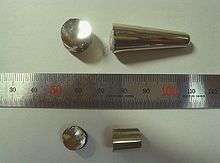
In the past, small batches of amorphous metals with high surface area configurations (ribbons, wires, films, etc.) have been produced through the implementation of extremely rapid rates of cooling. This was initially termed "splat cooling" by doctoral student W. Klement at Caltech, who showed that cooling rates on the order of millions of degrees per second is sufficient to impede the formation of crystals, and the metallic atoms become "locked into" a glassy state. Amorphous metal wires have been produced by sputtering molten metal onto a spinning metal disk. More recently a number of alloys have been produced in layers with thickness exceeding 1 millimeter. These are known as bulk metallic glasses (BMG). Liquidmetal Technologies sell a number of zirconium-based BMGs. Batches of amorphous steel have also been produced that demonstrate mechanical properties far exceeding those found in conventional steel alloys.[27][28][29]
In 2004, NIST researchers presented evidence that an isotropic non-crystalline metallic phase (dubbed "q-glass") could be grown from the melt. This phase is the first phase, or "primary phase", to form in the Al-Fe-Si system during rapid cooling. Interestingly, experimental evidence indicates that this phase forms by a first-order transition. Transmission electron microscopy (TEM) images show that the q-glass nucleates from the melt as discrete particles, which grow spherically with a uniform growth rate in all directions. The diffraction pattern shows it to be an isotropic glassy phase. Yet there is a nucleation barrier, which implies an interfacial discontinuity (or internal surface) between the glass and the melt.[30][31]
Electrolytes
Electrolytes or molten salts are mixtures of different ions. In a mixture of three or more ionic species of dissimilar size and shape, crystallization can be so difficult that the liquid can easily be supercooled into a glass. The best-studied example is Ca0.4K0.6(NO3)1.4.
Aqueous solutions
Some aqueous solutions can be supercooled into a glassy state, for instance LiCl:RH2O in the composition range 4<R<8.
Molecular liquids
A molecular liquid is composed of molecules that do not form a covalent network but interact only through weak van der Waals forces or through transient hydrogen bonds. Many molecular liquids can be supercooled into a glass; some are excellent glass formers that normally do not crystallize.
A widely known example is sugar glass.
Under extremes of pressure and temperature solids may exhibit large structural and physical changes that can lead to polyamorphic phase transitions.[32] In 2006 Italian scientists created an amorphous phase of carbon dioxide using extreme pressure. The substance was named amorphous carbonia(a-CO2) and exhibits an atomic structure resembling that of silica.[33]
Polymers
Important polymer glasses include amorphous and glassy pharmaceutical compounds. These are useful because the solubility of the compound is greatly increased when it is amorphous compared to the same crystalline composition. Many emerging pharmaceuticals are practically insoluble in their crystalline forms.[34]
Colloidal glasses
Concentrated colloidal suspensions may exhibit a distinct glass transition as function of particle concentration or density.[35][36][37]
In cell biology there is recent evidence suggesting that the cytoplasm behaves like a colloidal glass approaching the liquid-glass transition.[38][39] During periods of low metabolic activity, as in dormancy, the cytoplasm vitrifies and prohibits the movement to larger cytoplasmic particles while allowing the diffusion of smaller ones throughout the cell.[38]
Glass-ceramics
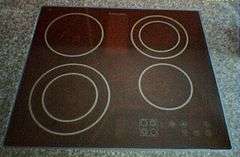
Glass-ceramic materials share many properties with both non-crystalline glass and crystalline ceramics. They are formed as a glass, and then partially crystallized by heat treatment. For example, the microstructure of whiteware ceramics frequently contains both amorphous and crystalline phases. Crystalline grains are often embedded within a non-crystalline intergranular phase of grain boundaries. When applied to whiteware ceramics, vitreous means the material has an extremely low permeability to liquids, often but not always water, when determined by a specified test regime.[40][41]
The term mainly refers to a mix of lithium and aluminosilicates that yields an array of materials with interesting thermomechanical properties. The most commercially important of these have the distinction of being impervious to thermal shock. Thus, glass-ceramics have become extremely useful for countertop cooking. The negative thermal expansion coefficient (CTE) of the crystalline ceramic phase can be balanced with the positive CTE of the glassy phase. At a certain point (~70% crystalline) the glass-ceramic has a net CTE near zero. This type of glass-ceramic exhibits excellent mechanical properties and can sustain repeated and quick temperature changes up to 1000 °C.[40][41]
Structure
As in other amorphous solids, the atomic structure of a glass lacks any long-range translational periodicity. Due to chemical bonding characteristics glasses do possess a high degree of short-range order with respect to local atomic polyhedra.[42]

Formation from a supercooled liquid
In physics, the standard definition of a glass (or vitreous solid) is a solid formed by rapid melt quenching.[43][44][45][46][47] The term glass is often used to describe any amorphous solid that exhibits a glass transition temperature Tg. If the cooling is sufficiently rapid (relative to the characteristic crystallization time) then crystallization is prevented and instead the disordered atomic configuration of the supercooled liquid is frozen into the solid state at Tg. The tendency for a material to form a glass while quenched is called glass-forming ability. This ability can be predicted by the rigidity theory.[48] Generally, the structure of a glass exists in a metastable state with respect to its crystalline form, although in certain circumstances, for example in atactic polymers, there is no crystalline analogue of the amorphous phase.[49]
Some people consider glass to be a liquid due to its lack of a first-order phase transition[50][51] where certain thermodynamic variables such as volume, entropy and enthalpy are discontinuous through the glass transition range. The glass transition may be described as analogous to a second-order phase transition where the intensive thermodynamic variables such as the thermal expansivity and heat capacity are discontinuous.[44] Nonetheless, the equilibrium theory of phase transformations does not entirely hold for glass, and hence the glass transition cannot be classed as one of the classical equilibrium phase transformations in solids.[46][47]
Glass is an amorphous solid. It exhibits an atomic structure close to that observed in the supercooled liquid phase but displays all the mechanical properties of a solid.[50][52] The notion that glass flows to an appreciable extent over extended periods of time is not supported by empirical research or theoretical analysis (see viscosity of amorphous materials). Laboratory measurements of room temperature glass flow do show a motion consistent with a material viscosity on the order of 1017–1018 Pa s.[53]
Although the atomic structure of glass shares characteristics of the structure in a supercooled liquid, glass tends to behave as a solid below its glass transition temperature.[54] A supercooled liquid behaves as a liquid, but it is below the freezing point of the material, and in some cases will crystallize almost instantly if a crystal is added as a core. The change in heat capacity at a glass transition and a melting transition of comparable materials are typically of the same order of magnitude, indicating that the change in active degrees of freedom is comparable as well. Both in a glass and in a crystal it is mostly only the vibrational degrees of freedom that remain active, whereas rotational and translational motion is arrested. This helps to explain why both crystalline and non-crystalline solids exhibit rigidity on most experimental time scales.
| | Unsolved problem in physics : What is the nature of the transition between a fluid or regular solid and a glassy phase?
"The deepest and most interesting unsolved problem in solid state theory is probably the theory of the nature of glass and the glass transition." —P.W. Anderson[55] (more unsolved problems in physics ) |
Behavior of antique glass
The observation that old windows are sometimes found to be thicker at the bottom than at the top is often offered as supporting evidence for the view that glass flows over a timescale of centuries, the assumption being that the glass has exhibited the liquid property of flowing from one shape to another.[56] This assumption is incorrect, as once solidified, glass stops flowing. The reason for the observation is that in the past, when panes of glass were commonly made by glassblowers, the technique used was to spin molten glass so as to create a round, mostly flat and even plate (the crown glass process, described above). This plate was then cut to fit a window. The pieces were not absolutely flat; the edges of the disk became a different thickness as the glass spun. When installed in a window frame, the glass would be placed with the thicker side down both for the sake of stability and to prevent water accumulating in the lead cames at the bottom of the window.[57] Occasionally such glass has been found installed with the thicker side at the top, left or right.[58]
Mass production of glass window panes in the early twentieth century caused a similar effect. In glass factories, molten glass was poured onto a large cooling table and allowed to spread. The resulting glass is thicker at the location of the pour, located at the center of the large sheet. These sheets were cut into smaller window panes with nonuniform thickness, typically with the location of the pour centered in one of the panes (known as "bull's-eyes") for decorative effect. Modern glass intended for windows is produced as float glass and is very uniform in thickness.
Several other points can be considered that contradict the "cathedral glass flow" theory:
- Writing in the American Journal of Physics, the materials engineer Edgar D. Zanotto states "…the predicted relaxation time for GeO2 at room temperature is 1032 years. Hence, the relaxation period (characteristic flow time) of cathedral glasses would be even longer."[59] (1032 years is many times longer than the estimated age of the universe.)
- If medieval glass has flowed perceptibly, then ancient Roman and Egyptian objects should have flowed proportionately more—but this is not observed. Similarly, prehistoric obsidian blades should have lost their edge; this is not observed either (although obsidian may have a different viscosity from window glass).[50]
- If glass flows at a rate that allows changes to be seen with the naked eye after centuries, then the effect should be noticeable in antique telescopes. Any slight deformation in the antique telescopic lenses would lead to a dramatic decrease in optical performance, a phenomenon that is not observed.[50]
- There are many examples of centuries-old glass shelving that has not bent, even though it is under much higher stress from gravitational loads than vertical window glass.
Gallery
 Ear stud, ca. 1390–1353 B.C.E., 48.66.30, Brooklyn Museum. The shafts of these brightly colored studs were inserted through a hole in the earlobe to display the studs' circular heads.
Ear stud, ca. 1390–1353 B.C.E., 48.66.30, Brooklyn Museum. The shafts of these brightly colored studs were inserted through a hole in the earlobe to display the studs' circular heads. Phoenician glass necklace 5th–6th century BC
Phoenician glass necklace 5th–6th century BC Roman glass amphoriskoi 1st–2nd century AD
Roman glass amphoriskoi 1st–2nd century AD.jpg) Blue head flask (Roman, AD 300–500, cast glass)
Blue head flask (Roman, AD 300–500, cast glass) Lombardic glass drinking horn 6th–7th century AD
Lombardic glass drinking horn 6th–7th century AD Two cups cobalt blue glass with gilt floral decoration from India, Mughal, circa 1700–1775
Two cups cobalt blue glass with gilt floral decoration from India, Mughal, circa 1700–1775_LACMA_M.76.2.20.jpg) Base for a water pipe, India, Mughal, circa 1700–1775
Base for a water pipe, India, Mughal, circa 1700–1775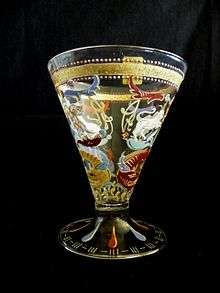 Venetian goblet made in Italy in the early 19th century.
Venetian goblet made in Italy in the early 19th century.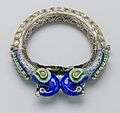 Bracelets with peacocks, Delhi, enameled silver inlaid with gemstones and glass, 19th century
Bracelets with peacocks, Delhi, enameled silver inlaid with gemstones and glass, 19th century Jug, 1876, James Powell & Sons
Jug, 1876, James Powell & Sons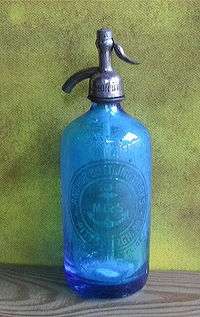 Siphon bottle for seltzer water, 1922
Siphon bottle for seltzer water, 1922- New Martinsville Glass Hostmaster Tea Cup, cobalt blue, 1930
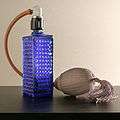 Perfume set from Soviet Union, ca. 1965
Perfume set from Soviet Union, ca. 1965 Murano millefiori glass vase
Murano millefiori glass vase Window glass
Window glass Detail from a glass chandelier
Detail from a glass chandelier Glass chandelier
Glass chandelier The Rotunda, or main entrance, of the Victoria and Albert Museum now sports a 30 ft high, blown glass chandelier by Dale Chihuly
The Rotunda, or main entrance, of the Victoria and Albert Museum now sports a 30 ft high, blown glass chandelier by Dale Chihuly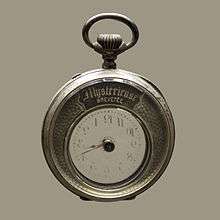 The using of glass dials in this "mystery watch" creates the illusion the hands move without movement
The using of glass dials in this "mystery watch" creates the illusion the hands move without movement
See also
References
- ↑ "Glass - Chemistry Encyclopedia". Retrieved 1 April 2015.
- 1 2 3 B. H. W. S. de Jong, "Glass"; in "Ullmann's Encyclopedia of Industrial Chemistry"; 5th edition, vol. A12, VCH Publishers, Weinheim, Germany, 1989, ISBN 978-3-527-20112-9, pp. 365–432.
- ↑ Pfaender, Heinz G. (1996). Schott guide to glass. Springer. pp. 135, 186. ISBN 978-0-412-62060-7. Retrieved 8 February 2011.
- ↑ Corning, Inc. Pyrex data sheet. (PDF). Retrieved 2012-05-15.
- ↑ AR-GLAS Schott, N.A., Inc data sheet
- ↑ Mining the sea sand. Seafriends.org.nz (1994-02-08). Retrieved 2012-05-15.
- ↑ Barsoum, Michel W. (2003). Fundamentals of ceramics (2 ed.). Bristol: IOP. ISBN 0-7503-0902-4.
- ↑ Donald R. Uhlmann; Norbert J. Kreidl, eds. (1991). Optical properties of glass. Westerville, OH: American Ceramic Society. ISBN 0-944904-35-1.
- ↑ "PFG Glass". Pfg.co.za. Retrieved 24 October 2009.
- ↑ Vogel, Werner (1994). Glass Chemistry (2 ed.). Springer-Verlag Berlin and Heidelberg GmbH & Co. K. ISBN 3-540-57572-3.
- ↑ Thomas P. Seward, ed. (2005). High temperature glass melt property database for process modeling. Westerville, Ohio: American Ceramic Society. ISBN 1-57498-225-7.
- ↑ David M Issitt. Substances Used in the Making of Coloured Glass 1st.glassman.com.
- ↑ "Glass Online: The History of Glass". Archived from the original on 24 October 2011. Retrieved 29 October 2007.
- ↑ True glazing over a ceramic body was not used until many centuries after the production of the first glass.
- ↑ Gowlett, J.A.J. (1997). High Definition Archaeology: Threads Through the Past. Routledge. ISBN 0-415-18429-0.
- ↑ Douglas, R. W. (1972). A history of glassmaking. Henley-on-Thames: G T Foulis & Co Ltd. ISBN 0-85429-117-2.
- ↑ Rene Hughe, Byzantine and Medieval Art, Paul Hamlyn, (1963)
- ↑ John Harvey, English Cathedrals, Batsford, (1961)
- ↑ Zolfagharifard, Ellie (15 October 2013). "How medieval stained-glass is creating the ultimate SPACE camera: Nanoparticles used in church windows will help scientists see Mars' true colours under extreme UV light". Daily Mail. London.
- ↑ History of Glass Manufacture: London Crown Glass co.
- 1 2 "Glass melting, Pacific Northwest National Laboratory". Depts.washington.edu. Retrieved 24 October 2009.
- ↑ Fluegel, Alexander. "Glass melting in the laboratory". Glassproperties.com. Retrieved 24 October 2009.
- ↑ Greer, A. Lindsay; Mathur, N (2005). "Materials science: Changing Face of the Chameleon". Nature. 437 (7063): 1246–1247. Bibcode:2005Natur.437.1246G. doi:10.1038/4371246a. PMID 16251941.
- ↑ Bourhis, Eric Le (2007). Glass: Mechanics and Technology. Wiley-VCH. p. 74. ISBN 3-527-31549-7.
- ↑ Shackelford, James F.; Doremus, Robert H. (2008). Ceramic and Glass Materials: Structure, Properties and Processing. Springer. p. 158. ISBN 0-387-73361-2.
- ↑ Doering, Robert; Nishi, Yoshio (2007). Handbook of semiconductor manufacturing technology. CRC Press. pp. 12–3. ISBN 1-57444-675-4.
- ↑ Klement, Jr., W.; Willens, R. H.; Duwez, Pol (1960). "Non-crystalline Structure in Solidified Gold-Silicon Alloys". Nature. 187 (4740): 869. Bibcode:1960Natur.187..869K. doi:10.1038/187869b0.
- ↑ Liebermann, H.; Graham, C. (1976). "Production of Amorphous Alloy Ribbons and Effects of Apparatus Parameters on Ribbon Dimensions". IEEE Transactions on Magnetics. 12 (6): 921. Bibcode:1976ITM....12..921L. doi:10.1109/TMAG.1976.1059201.
- ↑ Ponnambalam, V.; Poon, S. Joseph; Shiflet, Gary J. (2004). "Fe-based bulk metallic glasses with diameter thickness larger than one centimeter". Journal of Materials Research. 19 (5): 1320. Bibcode:2004JMatR..19.1320P. doi:10.1557/JMR.2004.0176.
- ↑ "Metallurgy Division Publications". NIST Interagency Report 7127.
- ↑ Mendelev, M. I.; Schmalian, J.; Wang, C. Z.; Morris, J. R.; K. M. Ho (2006). "Interface Mobility and the Liquid-Glass Transition in a One-Component System". Physical Review B. 74 (10). Bibcode:2006PhRvB..74j4206M. doi:10.1103/PhysRevB.74.104206.
- ↑ McMillan, P. F. (2004). "Polyamorphic Transformations in Liquids and Glasses". Journal of Materials Chemistry. 14 (10): 1506–1512. doi:10.1039/b401308p.
- ↑ Carbon dioxide glass created in the lab. NewScientist. 15 June 2006.
- ↑ Understanding polymer glasses
- ↑ Pusey, P. N.; Megen, W. van (1987). "Observation of a glass transition in suspensions of spherical colloidal particles". Physical Review Letters. 59 (18): 2083–2086. Bibcode:1987PhRvL..59.2083P. doi:10.1103/PhysRevLett.59.2083. PMID 10035413.
- ↑ Megen, W. Van; Underwood, S. (1993). "Dynamic-light-scattering study of glasses of hard colloidal spheres". Physical Review E. 47: 248. Bibcode:1993PhRvE..47..248V. doi:10.1103/PhysRevE.47.248.
- ↑ Löwen, H. (1996). A. K. Arora; B. V. R. Tata, eds. "Dynamics of charged colloidal suspensions across the freezing and glass transition" (PDF). Ordering and Phase Transitions in Charged Colloids. VCH Series of Textbooks on "Complex Fluids and Fluid Microstructures". New York: 207–234.
- 1 2 http://www.cell.com/abstract/S0092-8674%2813%2901479-7
- ↑ Munguira, Ignacio (9 February 2016). "Glasslike Membrane Protein Diffusion in a Crowded Membrane". ACS Nano. doi:10.1021/acsnano.5b07595. Retrieved 1 March 2016.
- 1 2 Kingery, W.D.; Uhlmann, H.K. Bowen, D.R. (1976). Introduction to ceramics (2 ed.). New York: Wiley. ISBN 978-0471478607.
- 1 2 Richerson, David W. (1992). Modern ceramic engineering : properties, processing and use in design (2 ed.). New York, NY: Dekker. ISBN 0-8247-8634-3.
- ↑ Salmon, P. S. (2002). "Order within disorder". Nature Materials. 1 (2): 87–8. doi:10.1038/nmat737. PMID 12618817.
- ↑ ASTM definition of glass from 1945; also: DIN 1259, Glas – Begriffe für Glasarten und Glasgruppen, September 1986
- 1 2 Zallen, R. (1983). The Physics of Amorphous Solids. New York: John Wiley. ISBN 0-471-01968-2.
- ↑ Cusack, N. E. (1987). The physics of structurally disordered matter: an introduction. Adam Hilger in association with the University of Sussex press. ISBN 0-85274-829-9.
- 1 2 Elliot, S. R. (1984). Physics of Amorphous Materials. Longman group ltd.
- 1 2 Scholze, Horst (1991). Glass – Nature, Structure, and Properties. Springer. ISBN 0-387-97396-6.
- ↑ Phillips, J.C. (1979). "Topology of covalent non-crystalline solids I: Short-range order in chalcogenide alloys". Journal of Non-Crystalline Solids. 34 (2): 153. Bibcode:1979JNCS...34..153P. doi:10.1016/0022-3093(79)90033-4.
- ↑ Folmer, J. C. W.; Franzen, Stefan (2003). "Study of polymer glasses by modulated differential scanning calorimetry in the undergraduate physical chemistry laboratory". Journal of Chemical Education. 80 (7): 813. Bibcode:2003JChEd..80..813F. doi:10.1021/ed080p813.
- 1 2 3 4 Gibbs, Philip. "Is glass liquid or solid?". Retrieved 21 March 2007.
- ↑ Loy, Jim. "Glass Is A Liquid?". Retrieved 21 March 2007.
- ↑ "Philip Gibbs" Glass Worldwide, (May/June 2007), pp. 14–18
- ↑ Vannoni, M.; Sordini, A.; Molesini, G. (2011). "Relaxation time and viscosity of fused silica glass at room temperature". Eur. Phys. J. E. 34: 9–14. doi:10.1140/epje/i2011-11092-9.
- ↑ Neumann, Florin. "Glass: Liquid or Solid – Science vs. an Urban Legend". Retrieved 8 April 2007.
- ↑ Anderson, P. W. (1995). "Through the Glass Lightly". Science. 267 (5204): 1615. doi:10.1126/science.267.5204.1615-e.
- ↑ Kenneth Chang (29 July 2008). "The Nature of Glass Remains Anything but Clear". The New York Times. Retrieved 29 July 2008.
- ↑ "Dr Karl's Homework: Glass Flows". Australia: ABC. 26 January 2000. Retrieved 24 October 2009.
- ↑ Halem, H. "Does Glass Flow". Retrieved 2 September 2010.
- ↑ Zanotto, Edgar Dutra (1998). "Do Cathedral Glasses Flow?". American Journal of Physics. 66 (5): 392–396. Bibcode:1998AmJPh..66..392Z. doi:10.1119/1.19026.
Further reading
- Stefano, Carboni,; David, Whitehouse, (2001). Glass of the Sultans. New York: The Metropolitan Museum of Art. ISBN 0-87099-986-9.
- Ghosh, Amalananda (1990). An Encyclopaedia of Indian Archaeology. BRILL. ISBN 90-04-09262-5.
- Gowlett, J. A. J. (1997). High Definition Archaeology: Threads Through the Past. Routledge. ISBN 0-415-18429-0.
- Noel C. Stokes; The Glass and Glazing Handbook; Standards Australia; SAA HB125–1998
- staff (2 November 2011). "Robot speeds up glass development" (press release). Fraunhofer Institute. Retrieved 10 December 2011. (reprinted by R&D Magazine)
- Stookey, S. Donald. Explorations in Glass: An Autobiography. Wiley, 2000. ISBN 978-1-57498-124-7
- Vogel, Werner. Chemistry of Glass. Wiley, 1985. ISBN 978-0-916094-73-7
External links
 "Glass". Encyclopædia Britannica. 12 (11th ed.). 1911.
"Glass". Encyclopædia Britannica. 12 (11th ed.). 1911.- The Story of Glass Making in Canada from The Canadian Museum of Civilization.
- "How Your Glass Ware Is Made" by George W. Waltz, February 1951, Popular Science.
- All About Glass from the Corning Museum of Glass: a collection of articles, multimedia, and virtual books all about glass, including the Glass Dictionary.
- Glass Encyclopedia from 20th Century Glass: a comprehensive guide to all types of antique and collectible glass, with information, pictures and references.
- National Glass Association the largest trade association representing the flat (architectural), auto glass, and window & door industries